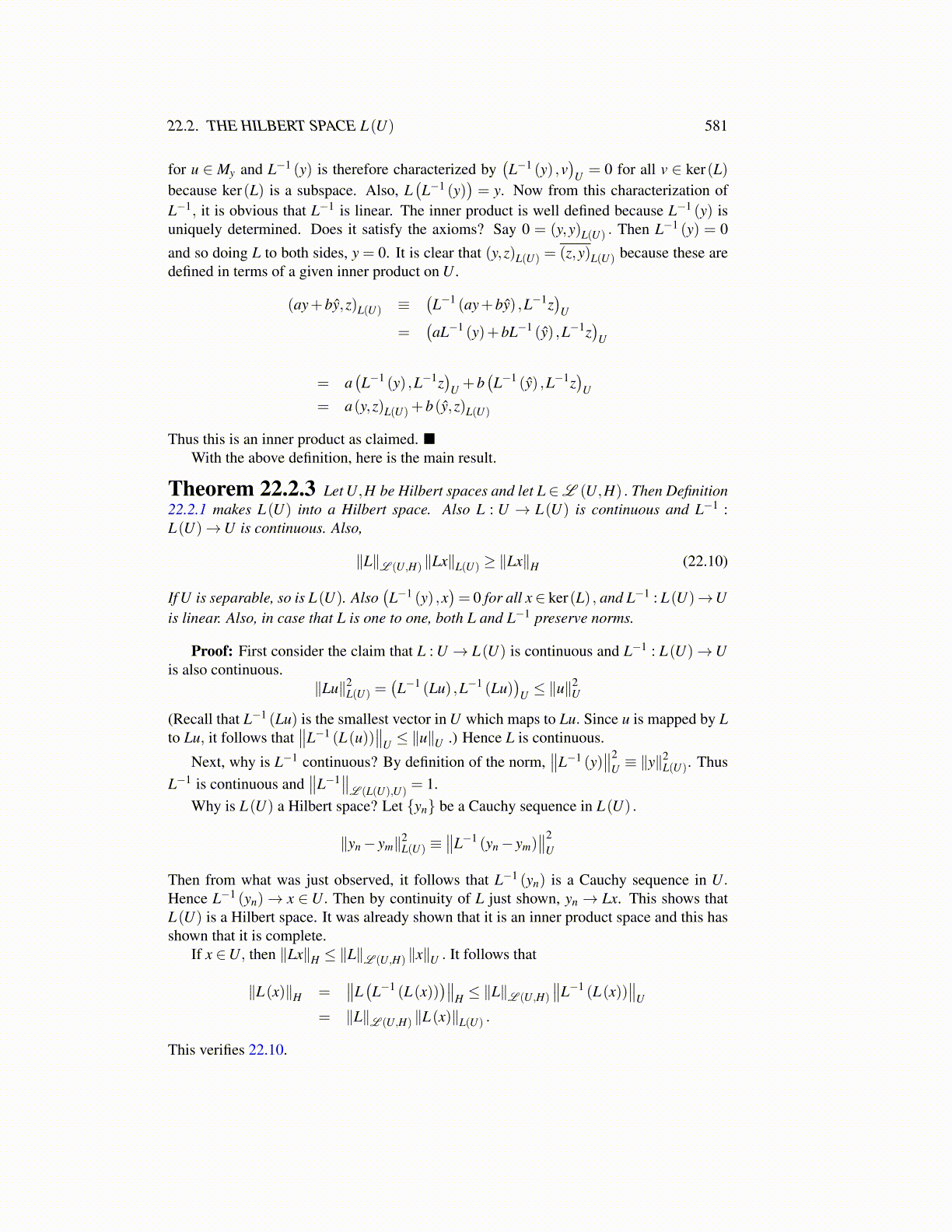
22.2. THE HILBERT SPACE L(U) 581
for u ∈ My and L−1 (y) is therefore characterized by(L−1 (y) ,v
)U = 0 for all v ∈ ker(L)
because ker(L) is a subspace. Also, L(L−1 (y)
)= y. Now from this characterization of
L−1, it is obvious that L−1 is linear. The inner product is well defined because L−1 (y) isuniquely determined. Does it satisfy the axioms? Say 0 = (y,y)L(U) . Then L−1 (y) = 0
and so doing L to both sides, y = 0. It is clear that (y,z)L(U) = (z,y)L(U) because these aredefined in terms of a given inner product on U .
(ay+bŷ,z)L(U) ≡(L−1 (ay+bŷ) ,L−1z
)U
=(aL−1 (y)+bL−1 (ŷ) ,L−1z
)U
= a(L−1 (y) ,L−1z
)U +b
(L−1 (ŷ) ,L−1z
)U
= a(y,z)L(U)+b(ŷ,z)L(U)
Thus this is an inner product as claimed. ■With the above definition, here is the main result.
Theorem 22.2.3 Let U,H be Hilbert spaces and let L ∈L (U,H) . Then Definition22.2.1 makes L(U) into a Hilbert space. Also L : U → L(U) is continuous and L−1 :L(U)→U is continuous. Also,
∥L∥L (U,H) ∥Lx∥L(U) ≥ ∥Lx∥H (22.10)
If U is separable, so is L(U). Also(L−1 (y) ,x
)= 0 for all x∈ ker(L) , and L−1 : L(U)→U
is linear. Also, in case that L is one to one, both L and L−1 preserve norms.
Proof: First consider the claim that L : U → L(U) is continuous and L−1 : L(U)→Uis also continuous.
∥Lu∥2L(U) =
(L−1 (Lu) ,L−1 (Lu)
)U ≤ ∥u∥
2U
(Recall that L−1 (Lu) is the smallest vector in U which maps to Lu. Since u is mapped by Lto Lu, it follows that
∥∥L−1 (L(u))∥∥
U ≤ ∥u∥U .) Hence L is continuous.
Next, why is L−1 continuous? By definition of the norm,∥∥L−1 (y)
∥∥2U ≡ ∥y∥
2L(U). Thus
L−1 is continuous and∥∥L−1
∥∥L (L(U),U)
= 1.Why is L(U) a Hilbert space? Let {yn} be a Cauchy sequence in L(U) .
∥yn− ym∥2L(U) ≡
∥∥L−1 (yn− ym)∥∥2
U
Then from what was just observed, it follows that L−1 (yn) is a Cauchy sequence in U.Hence L−1 (yn)→ x ∈U. Then by continuity of L just shown, yn → Lx. This shows thatL(U) is a Hilbert space. It was already shown that it is an inner product space and this hasshown that it is complete.
If x ∈U, then ∥Lx∥H ≤ ∥L∥L (U,H) ∥x∥U . It follows that
∥L(x)∥H =∥∥L(L−1 (L(x))
)∥∥H ≤ ∥L∥L (U,H)
∥∥L−1 (L(x))∥∥
U
= ∥L∥L (U,H) ∥L(x)∥L(U) .
This verifies 22.10.